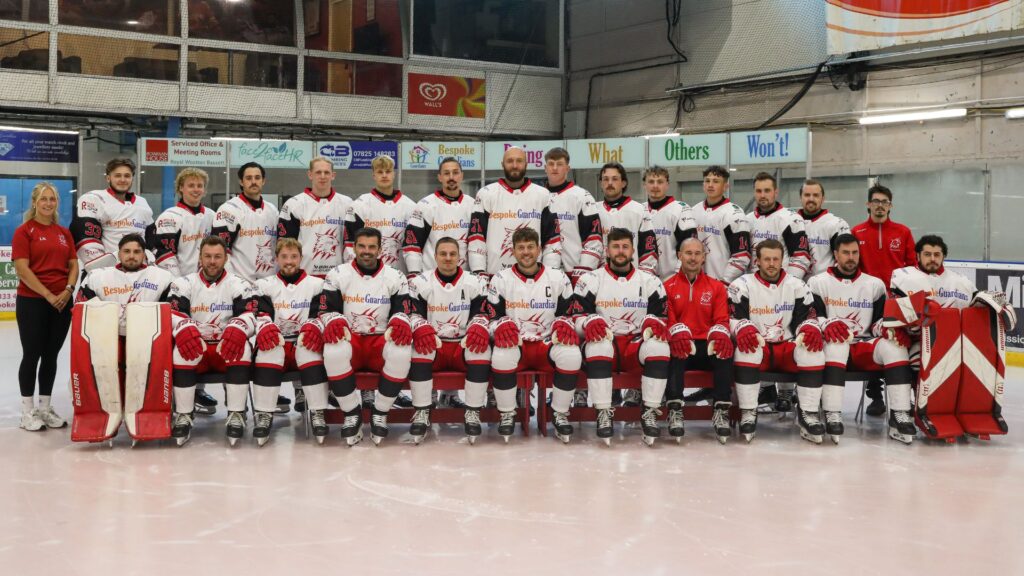The NIHL (National Ice Hockey League) is one of the key tiers of British ice hockey, sitting just below the top-level EIHL. It brings together clubs from across England, Wales, and occasionally Scotland, creating a competitive environment for both established players and emerging talent.
The league bridges the gap between professional and semi-professional hockey, giving fans high-intensity games packed with physical play and strong local rivalries. Over recent years, the NIHL has become an essential part of player development, offering a pathway to higher competition while keeping the spirit of community hockey alive.
NIHL Structure and Divisions
The National Ice Hockey League (NIHL) operates as the second and third tier of the British ice hockey system, sitting just beneath the Elite Ice Hockey League (EIHL). It’s a large, competitive structure that delivers organised hockey nationwide and ensures consistent player development opportunities.

National Division
At the top of the NIHL pyramid sits the National Division, home to some of the strongest semi-professional teams in the UK. Matches here often draw impressive crowds and deliver intensity close to EIHL level. Teams usually combine experienced British players, a few imports from Europe or North America, and talented young prospects.
The National Division plays around 48-52 regular-season games, followed by playoffs that decide the national champions.
Division 1 – North & South
Below the top tier, the league splits into Division 1 North and Division 1 South. This structure reduces travel demands and strengthens regional rivalries that drive fan engagement.
Each conference crowns its own champion, with top sides often meeting in national playoffs. Promotion to the National Division is open to clubs meeting both performance and operational criteria, balancing ambition with sustainability.
Division 2 – Regional Groups
Division 2 forms the base of the NIHL system and focuses on grassroots development. Divided into regional sections such as North 2 (Laidler) and South 2, it allows younger or less-experienced players to gain competitive ice time and progress through the ranks.
Altogether, around 50 teams compete nationwide. The promotion and relegation system keeps competition tight and ambitions high, ensuring steady growth across all levels of the league.
Key Differences from EIHL
The NIHL operates on a semi-professional basis, which sets it apart from the fully professional EIHL. Most NIHL players balance hockey with full-time or part-time jobs, often training in the evenings and competing on weekends.
Main differences include:
• Budgets: NIHL teams operate on £50,000-£150,000 per season, compared with £500,000-£1.5 million in the EIHL.
• Player status: NIHL players are largely semi-professional, while EIHL rosters are fully professional.
• Team composition: Predominantly British players with only 2-4 imports allowed per team.
• Crowds: Typical attendances of 200-800 fans, against 1,500-5,000 in EIHL arenas.
• Game pace and coverage: NIHL matches are less physical and receive limited broadcast exposure compared with the top flight.
Despite these contrasts, the NIHL plays a vital role in British hockey — developing talent, keeping clubs sustainable, and nurturing passionate local rivalries.
Notable NIHL Teams
Several clubs define the competitiveness and character of the NIHL, each bringing its own tradition and ambition.
Swindon Wildcats
The Swindon Wildcats stand as the most successful side in the modern NIHL era. Consistently among the top contenders, they’ve claimed multiple league titles and playoff championships. Known for disciplined defence and sharp finishing, the Wildcats also invest heavily in local youth development.

Milton Keynes Lightning
Milton Keynes Lightning have top-flight ambitions. After a period in the EIHL, the club returned to the NIHL to rebuild sustainably. With solid attendance numbers and a professional setup, Lightning remain among the most capable of eventually stepping back up to the top tier.
Leeds Knights
The Leeds Knights are one of the league’s fastest-growing clubs. Backed by significant new investment, they combine strong community engagement with competitive results. The Knights regularly sit near the top of the National Division and draw some of the NIHL’s largest crowds.
Hull Seahawks and Others
The Hull Seahawks represent a proud hockey city with deep roots in the British game. Revived under new management, the team continues to rebuild its local support. Other respected sides — including Peterborough Phantoms, Telford Tigers, and Sheffield Steeldogs — have contributed to British hockey’s player development and enduring competitiveness.
Together, these clubs give the NIHL its identity: passionate, regional, and fiercely contested.
NIHL Competition Format
The NIHL season runs from September to March, with teams playing each opponent multiple times in a balanced schedule. The campaign tests team depth and consistency across roughly 48-52 games for National Division clubs.
The season concludes with Playoffs in March and April, ending in the famous Final Four Weekend, where the top four teams meet at a single venue for semi-finals and a championship game. It’s the highlight of the NIHL calendar and draws some of the league’s biggest crowds.
Alongside league play runs the NIHL National Cup (also known as the Challenge Cup), providing extra fixtures and another route to silverware through group stages and knockouts.
The format guarantees competitive hockey throughout the season and a thrilling conclusion for fans and players alike.
Betting on NIHL Games
Betting coverage on NIHL games remains limited, with only a few UK bookmakers offering markets. During the regular season, odds are often sparse due to low liquidity and less available data compared with top-tier leagues such as the EIHL or NHL. Some punters occasionally compare NIHL prices with those seen on a bookmakers not on GamStop, simply to judge whether certain lines look unusually short or generous, but overall the market stays niche.
Interest rises during the Final Four Weekend, when increased media coverage and high-stakes matches attract more betting activity. The short, knockout format offers punters opportunities to back form teams or individual game outcomes.
For those who follow NIHL hockey closely, knowledge of team form, player availability, and travel demands can offer an advantage – but overall, NIHL betting remains a niche market with fewer options and less competitive odds than major leagues.
